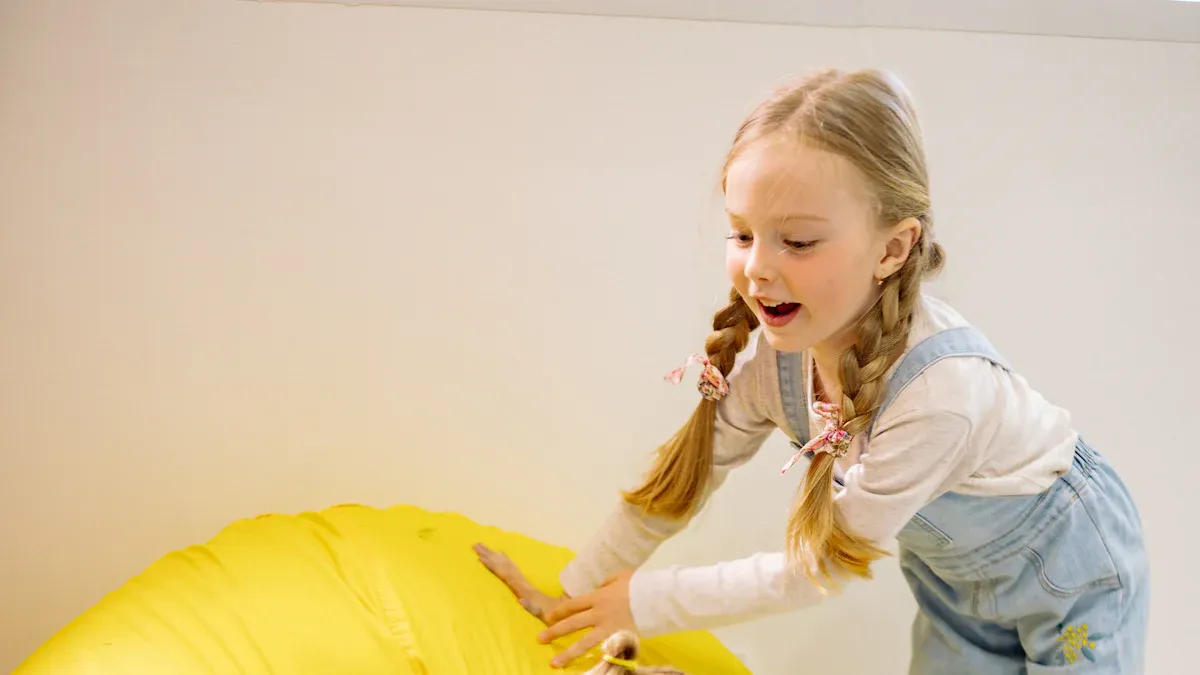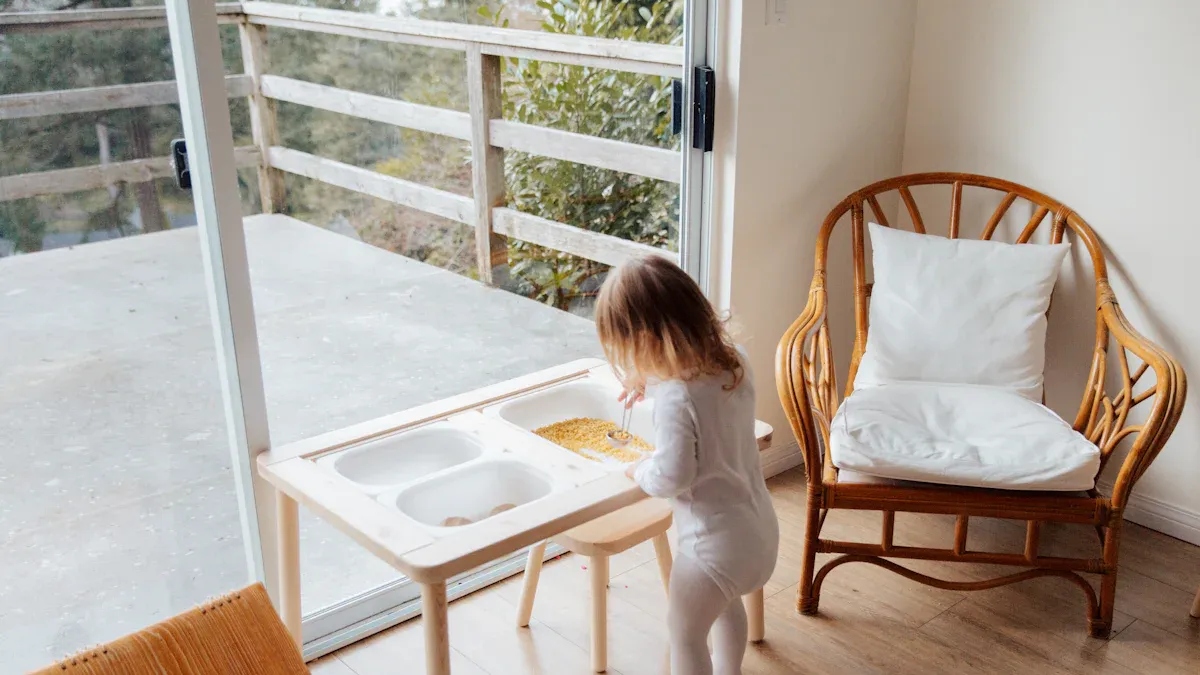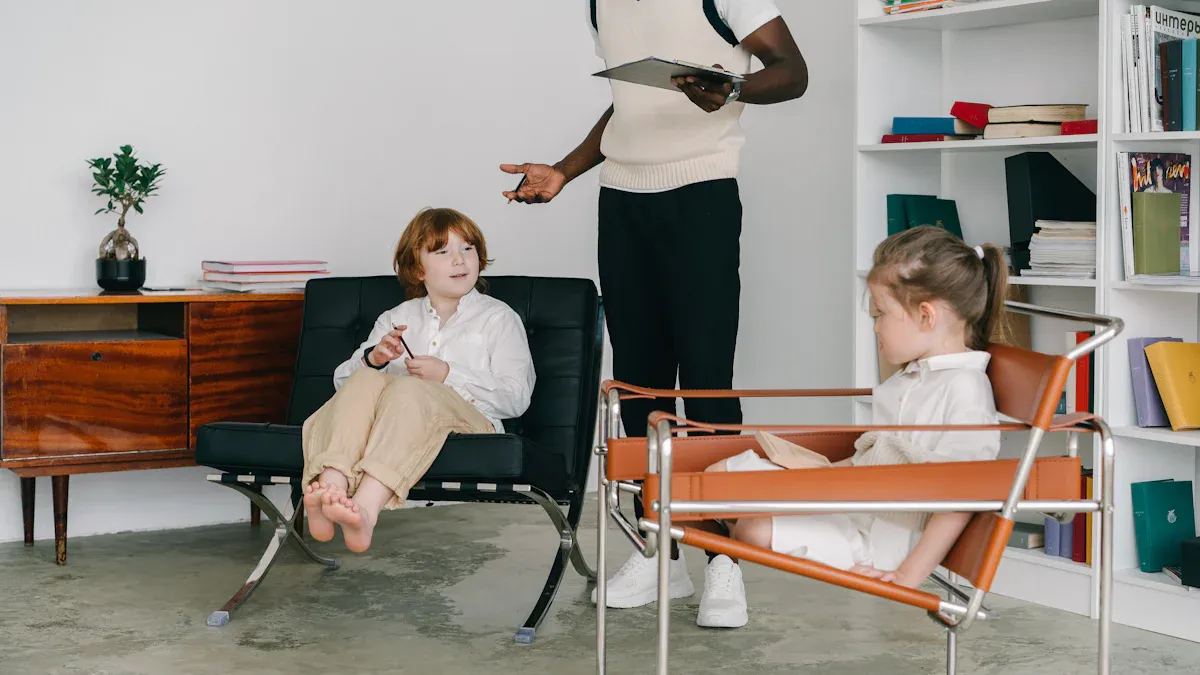How to Choose the Best Sensory Chair for Your Child

You want your child to feel safe and supported. This is important if your child has sensory processing challenges. Choosing the right sensory chair can help a lot. Your child might like the soft Peapod Chair. They might enjoy the gentle movement of an Egg Pod Chair. Some kids like the soft squeeze of a Bean Bag Chair. Other kids have fun spinning in a Carousel Spinning Seat. Each child is unique, so ask an occupational therapist or pediatrician for advice. This can help you pick the best chair for your child.
Key Takeaways
Pick a sensory chair that fits your child's needs. Think about what helps them feel calm and comfortable. Notice if they like to move or need pressure.
Safety is very important when you pick a sensory chair. Make sure the chair is made from strong materials. Check that the edges are smooth. Look for safety labels to keep your child safe.
Let your child help choose the chair. Allow them to try different chairs. See which one makes them happy and relaxed.
Watch how your child reacts to different chairs. This helps you know which features help them focus and stay calm.
Check the chair often for damage or problems. Make sure it stays safe and comfy as your child grows and their needs change.
What Is a Sensory Chair?

Definition
A sensory chair is a special seat for kids with sensory needs. You can find these chairs at home, in school, or at therapy places. Sensory chairs come in different shapes and sizes. Some look like bean bags. Others can rock, spin, or give a gentle hug. The main purpose is to give your child a safe spot. They can move, relax, or focus there. If your child has trouble with sensory processing, a sensory chair can help them every day.
Benefits
You might wonder why parents and teachers pick sensory chairs. These chairs do more than just give a soft place to sit. Here are some of the main benefits:
Improved focus
Emotional regulation
Support for skill-building
Let’s look at how sensory chairs are different from regular chairs:
Feature | Sensory Chairs | Traditional Seating |
|---|---|---|
Movement | Allows fidgeting and movement | Restricts movement |
Focus | Can lead to frustration and overload | |
Engagement | Supports self-regulation | May not accommodate movement needs |
You may see that sensory chairs like wobble stools or balance cushions let your child move. This does not bother others. Rocking chairs give gentle movement. This can help your child feel calm. Flexible seating makes a friendly place for your child to learn and grow.
Tip: If your child has trouble sitting still or feels nervous in regular chairs, a sensory chair might help them feel better and pay attention.
Understanding Your Child’s Needs
Sensory Preferences
All kids react to things in their own way. Some kids want to move a lot or touch things. Others get upset by loud sounds or bright lights. You might see your child jump, spin, or want hugs. Some kids cover their ears or stay away from certain things. To learn what your child likes, try these ideas:
Watch how your child acts with sounds, lights, and textures at home or outside.
Use simple checklists to keep track of what your child likes or avoids.
Talk to an occupational therapist. They can help you learn about your child’s sensory needs and give advice about chairs.
Tip: Watching your child closely helps you see patterns. This makes it easier to pick a chair that fits their needs.
Physical and Safety Considerations
Safety is the most important thing when picking a sensory chair. The chair should support your child’s body and keep them safe. Look for strong materials, smooth edges, and tight seams. Some chairs have extra safety parts like non-slip bottoms or handles. Always check for safety labels before you buy. Here are some common ones:
Certification | Description |
|---|---|
CPSIA | Follows the US rules for children’s product safety. |
CPSC Certified | Meets the rules from the safety commission. |
ASTM Certified | Passes the American testing standards. |
UL Certified | Electronic parts are checked for safety. |
ADA Compliant | Good for wheelchair access. |
Prop 65 | Warns about harmful chemicals. |
The chair should fit your child’s size and weight. Make sure your child can get in and out easily. If your child needs more support, look for chairs with armrests or deep seats.
Setting and Usage
Think about where your child will use the sensory chair. The right place can help a lot. At home, you can make a calm spot with pillows and soft lights. In class, bean bags or wobble cushions help kids who need to move. In therapy, there are special areas with different chairs for different things.
Keep the space neat to avoid too much stuff.
Use soft lights instead of bright ones.
Make quiet spots or calm corners for breaks.
Every space is different. You can change the area to fit your child. Even small changes, like adding a weighted blanket or moving the chair, can help your child feel safe and happy.
Types of Sensory Chairs

Choosing the right sensory chair can feel overwhelming. You have many options, and each one offers unique sensory support. Let’s break down the most common types of sensory chairs so you can find the best fit for your child.
Bean Bag Chairs
Bean bag chairs are a classic choice for comfort and relaxation. You might notice your child sinking into a bean bag after a long day. The soft filling molds to their body, giving a gentle hug that can help with deep pressure stimulation. Some bean bags even come with weighted features or textured covers for extra sensory input.
A good bean bag sensory chair can help your child calm down, read, or take a break.
Weighted sensory bean bags provide extra deep pressure, which is great for kids with autism or those who crave a sense of security.
Textured bean bags add a tactile experience, letting your child explore different surfaces.
Tip: Look for bean bags with removable, washable covers. Polystyrene beads and shredded foam are popular fillings. They offer flexibility and comfort, but you should check for durability if your child uses the chair often.
Rocking and Swivel Chairs
Rocking and swivel chairs bring movement into your child’s daily routine. These chairs let your child rock, spin, or sway, which can help them stay focused or calm. Some popular options include Ricochet stools with rounded bases and Ruckus chairs with 360-degree seats.
Rocking chairs give gentle, rhythmic motion. This can soothe children who feel anxious or need to move.
Swivel chairs allow spinning and turning. This helps kids who seek vestibular input or need to fidget while working.
Some chairs, like the VEVOR Kids Swivel Chair, are designed for ages 3-12 and support up to 220 lbs.
Note: Always check the chair’s stability and weight limit. Make sure your child can get in and out safely. Choose chairs with sturdy frames and smooth edges for extra safety.
Ball Chairs
Ball chairs, sometimes called balance balls or yoga balls, encourage active sitting. Your child sits on a large, inflatable ball, which keeps their core muscles engaged. This type of sensory chair is perfect for kids who need to move while they work or play.
Ball chairs support postural control and balance.
They help children who fidget or have trouble sitting still.
Some ball chairs come with a base or frame to prevent rolling.
You can also find floor cushions and wobble stools that offer similar benefits. These options let your child move without leaving their seat, which can boost focus and engagement.
Tip: Ball chairs work best for children who can balance safely. Always supervise younger kids and choose the right size for your child’s height.
Compression Chairs
Compression chairs give your child a gentle squeeze, like a big hug. These chairs use stretchy fabric or foam to wrap around the body, providing deep pressure stimulation. This type of sensory support can help children feel calm and secure, especially if they get overwhelmed easily.
Compression chairs are great for kids who seek deep pressure or need help with self-regulation.
Some designs use Lycra or spandex fabric, which stretches and moves with your child.
Others use foam padding for a snug, cozy feel.
Note: Make sure the chair fits your child’s size and weight. Too much compression can be uncomfortable, while too little may not provide enough support.
Materials, Durability, and Cleaning
When you pick a sensory chair, think about the materials. The right fabric can make a big difference in comfort and care.
Material Type | Durability Impact | Ease of Cleaning Impact |
|---|---|---|
Soft Fabrics | Comfortable but may wear over time | May need regular washing |
High-Density Foam | Keeps shape and support | Easy to wipe clean |
Faux Fur | Soft and inviting, traps dirt | Needs special care |
Cotton | Breathable, stains easily | Requires regular washing |
Microfiber | Soft, durable | Easy to wipe clean |
Leather/Faux Leather | Durable, easy to clean | Wipes clean but less cozy |
Polystyrene beads are light and flexible, making bean bags easy to move.
Memory foam adds support and keeps its shape.
Microfiber and faux leather are easy to clean, which is helpful for busy families.
Tip: Always check the chair’s size and weight limit. Make sure it fits your child and the space you have at home or school.
Quick Comparison of Sensory Chair Types
Bean Bag Chairs: Best for relaxation, deep pressure, and tactile input.
Rocking/Swivel Chairs: Great for movement, vestibular input, and focus.
Ball Chairs: Support posture, balance, and active sitting.
Compression Chairs: Offer deep pressure stimulation and calming effects.
You can find many types of sensory chairs on the market. Each one supports different needs, so think about what helps your child feel safe and happy. If you’re not sure, ask your child what they like or try out a few options together.
Choosing the Right Sensory Chair
Matching Features to Needs
You want your child to feel comfortable and supported. The best way to do this is to match the chair’s features to your child’s sensory profile. Every child has different needs. Some kids need deep pressure, while others want movement or extra support. Start by thinking about what helps your child focus or calm down during sensory processing.
Here’s a table to help you see which features might help your child:
Feature | Benefit |
|---|---|
Molds to your child’s shape for pressure relief and even weight distribution. | |
Contoured Gel Pad | Reduces hotspots and keeps the seat cool and comfy. |
Wedge Support | Helps your child sit up straight and avoid slouching. |
Adjustable Headrest | Supports the head and neck in different positions. |
Lateral Pads | Cradles the head and keeps it from swaying. |
Noise-Muffling Wheel Covers | Makes outings quieter for kids who are sensitive to sound. |
Oral Sensory Tools (Chewies) | Gives a safe way to chew, which can help with anxiety and self-regulation. |
You might also want to look for chairs with adaptive features. These can help your child sit with better posture and feel more stable. Handles make it easier to move the chair. A stable base keeps your child safe, especially if they like to rock or bounce. Adjustable parts let you change the chair as your child grows.
Adaptive chairs help your child sit up straight and feel steady.
Good support for the head and trunk means your child can focus on learning or playing.
Customizable features let you pick what works best for your child’s needs.
Some children need extra sensory input to stay focused. You can find chairs with rocking, bouncing, or tactile cushions. These options help your child move safely while sitting.
Feature | Benefit |
|---|---|
Supports natural alignment and reduces strain. | |
Adjustable Seat Height | Lets you set the right height for comfort and posture. |
Sensory Stimulation Options | Gives extra sensory input to help your child pay attention. |
Stability Balls | Encourages active sitting for kids who need to move. |
Tactile Cushions | Offers sensory feedback to boost concentration. |
Rocking Mechanisms | Gentle movement can calm your child and help them focus. |
Bounce Chairs | Lets your child move a little, which can reduce restlessness. |
Rubber Band Chairs | Combines sitting with movement to release extra energy. |
Tip: Watch how your child reacts to different features. You might notice they love rocking or need a chair that hugs them. This helps you pick the right sensory chair for their needs.
Evaluating Quality and Price
You want a chair that lasts and keeps your child safe. Look for strong materials, tight seams, and sturdy frames. Check the weight limit and make sure the chair fits your child’s size. Easy-to-clean fabrics save you time and stress.
When you compare prices, remember that higher cost does not always mean better quality. Some affordable chairs have great features and last a long time. Make a list of what matters most to you—like safety, comfort, or easy cleaning. Then, compare your top choices.
Here are some things to check:
Does the chair have safety certifications?
Are the materials durable and easy to clean?
Can you adjust the chair as your child grows?
Does the chair fit your budget?
Note: You do not have to buy the most expensive chair. Focus on the features that help your child the most.
Making the Final Decision
You know your child best. Involve them in the process if you can. Let them try out different chairs or pick their favorite color. This helps your child feel excited about using their new chair.
Here’s a simple checklist to guide you:
List your child’s top sensory needs.
Pick the features that match those needs.
Check the chair’s safety and durability.
Compare prices and read reviews.
Let your child test the chair if possible.
Callout: Choosing the right sensory chair can make a big difference for your child. You give them a safe place to relax, focus, and enjoy sensory input every day.
You want your child to feel comfortable and safe. Start by noticing their sensory needs, then look at different chair types. Match features to what helps your child most. Ask professionals for advice and check safety, durability, and price. Before you buy, use this checklist:
Does the chair fit your child’s size and needs?
Can you clean it easily?
Do you see any signs of wear?
Is the chair stored in a dry place?
Will you need professional repairs for damage?
Finding the right sensory chair can make your child’s day brighter and calmer. 😊
FAQ
How do I know if my child needs a sensory chair?
Watch your child during daily activities. Do they fidget, avoid certain seats, or seek movement? If you notice these signs, a sensory chair might help. You can also ask your child’s therapist or teacher for advice.
Can my child use a sensory chair at school?
Yes! Many schools allow sensory chairs in classrooms. You should talk to your child’s teacher or school counselor first. They can help you find the best spot and make sure the chair fits classroom rules.
How do I clean a sensory chair?
Most sensory chairs have removable covers. You can wash these in the machine. For chairs without covers, use a damp cloth and mild soap. Always check the care label before cleaning.
What if my child does not like the chair I picked?
Don’t worry! Kids sometimes need time to adjust. Try letting your child help pick the chair next time. You can also test different types together. Involving your child makes them feel included and excited.
Are sensory chairs safe for all ages?
Most sensory chairs are safe for kids ages 3 and up. Always check the weight and age limits. Supervise younger children when they use the chair. Look for safety certifications on the product label.
See Also
Essential Guidelines for Choosing the Best Sensory Swing
Comparing Sensory Walls to Discover the Ideal Option
Favorite Sensory Toys Chosen by Parents for Their Children
